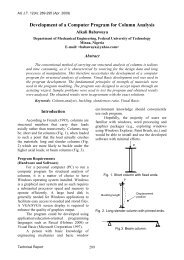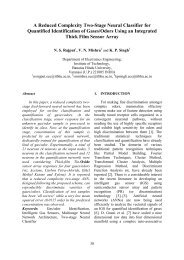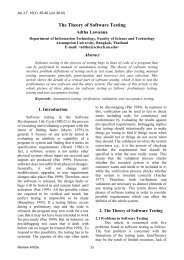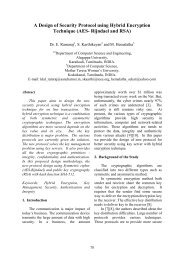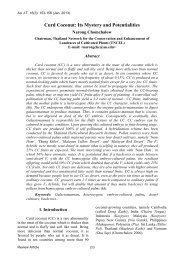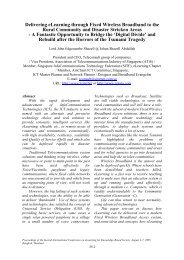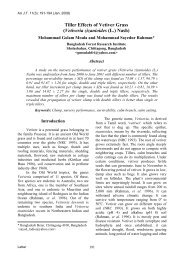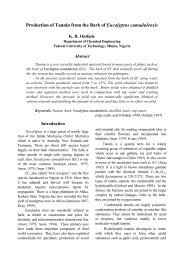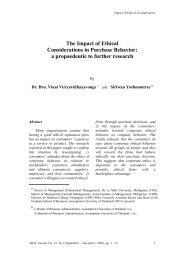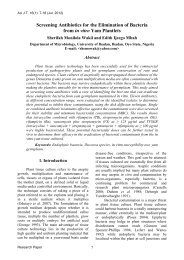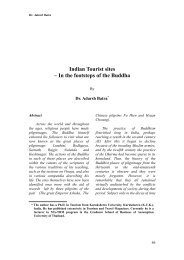Earthquake - AU Journal
Earthquake - AU Journal
Earthquake - AU Journal
You also want an ePaper? Increase the reach of your titles
YUMPU automatically turns print PDFs into web optimized ePapers that Google loves.
<strong>AU</strong> J.T. 8(3): 158-164 (Jan. 2005)<br />
<strong>Earthquake</strong><br />
Sr. Little flower<br />
Faculty of Arts, Assumption University<br />
Bangkok, Thailand<br />
Abstract<br />
<strong>Earthquake</strong>s are movements within the earth caused by natural and man-made<br />
stresses. Forces inside the earth sometimes push and stretch rocks in the crust. The<br />
rocks can absorb this energy for a time, but eventually as the energy accumulates, the<br />
stress can exceed the binding energy and the rocks suddenly shift or break. The energy<br />
is released as seismic waves, which are vibrations that spread through the rocks rapidly<br />
in all directions that can cause one of the most powerful events in nature, as earthquake.<br />
Keywords: Crust, epicenter, fault, focus, magnitude, Moho, mantle, primary wave,<br />
secondary wave, seismic wave, seismograph, seismologist, surface wave, Tsunamis.<br />
Introduction<br />
The tremors at or near the surface of the<br />
earth are called an earthquake. If the magnitude<br />
of the tremor is negligible, we are not able to<br />
feel it, and if it is more, we can feel. There are<br />
thousands of tremors occur at the surface of the<br />
earth every year, but only a few become<br />
problematic and are taken in to account.<br />
<strong>Earthquake</strong>s unleash energies on the<br />
scale of nuclear explosions. While they rarely<br />
announce their arrival in advance, even the<br />
strongest quakes are over in a matter of<br />
movements. Even the moderate earthquakes<br />
leave behind death and destruction that occupy<br />
victims and caregivers for years. The effect of<br />
an earthquake depends on nature of the earth’s<br />
crust and epicenter.<br />
Causes of <strong>Earthquake</strong><br />
Forces Inside The Earth<br />
Forces inside the earth cause faulting.<br />
Rocks break and move along surfaces called<br />
faults. The rocks on either side of a fault move<br />
in different directions. What causes the forces<br />
that cause faults to form? Obviously some<br />
thing must cause the rocks to move, otherwise,<br />
the rocks would rest quietly without any stress<br />
building up in them. However, the earth’s crust<br />
is in constant motion because of forces inside<br />
the earth. These forces cause sections of the<br />
earth’s crust to move, putting stress on rocks.<br />
To relive these stresses, the rocks tend to bend,<br />
compress, and stretch like plastic or rubber<br />
bands. But if the force is great enough, the rock<br />
breaks. This breaking produces vibrations,<br />
called earthquakes.<br />
Types of Faults<br />
Rocks experience several types of forces<br />
where plates of the earth’s crust and upper<br />
mantle meet. There are three forces -<br />
compression, tension, and shear. Compression<br />
is a force or stress that squeezes and<br />
compresses, while tension is the stress that<br />
causes stretching and elongation. Shear is the<br />
force that causes slippage and the rock on<br />
either side of fault to move fast each other.<br />
Normal Faults: Where forces inside the<br />
earth cause plates to move apart, the plates and<br />
the rocks that compose them are subjected to<br />
the force of tension. Tension can pull rocks<br />
apart and create a normal fault. Along a normal<br />
158
<strong>AU</strong> J.T. 8(3): 158-164 (Jan. 2005)<br />
fault, rock above the fault surface moves downward<br />
in relation to rock below the fault surface.<br />
Reverse Faults: Compression forces are<br />
generated where the earth’s plates come<br />
together. Compression pushes on rocks from<br />
opposite directions and causes them to bend<br />
and sometimes break. Once they break, the<br />
rocks continue to move along the reverse fault<br />
surface. At a reverse fault, the rocks above the<br />
fault surface are forced up and over the rocks<br />
below the fault surface.<br />
Strike Slip Faults: At a strike slip fault,<br />
rocks on either side of the fault surface are<br />
moving past each other without much upward<br />
or downward movement. As the rocks move<br />
fast each other at a strike-slip fault, their<br />
irregular surfaces snag each other, and the<br />
rocks are twisted and strained. Not only are<br />
they deformed, but also, the snagging of the<br />
irregular surface hinders the movements of the<br />
plates. As forces keep driving the plates to<br />
move, the stress builds up and the rocks reach<br />
their elastic limit. When the rocks are stressed<br />
past their elastic limits, they break and an<br />
earthquake results.<br />
<strong>Earthquake</strong> Information<br />
Types of Seismic Waves<br />
When we play with a coiled spring toy,<br />
energy waves are sent through it. Seismic<br />
waves, generated by an earthquake, are similar<br />
to the waves of the toy. Where are seismic<br />
waves formed? How do they move through<br />
earth and how can we use the information that<br />
they carry?<br />
<strong>Earthquake</strong> Focus: When rock move along<br />
a fault surface, energy is released and damage<br />
occurs. The point in the earth’s interior where<br />
this energy-release occurs is the focus of the<br />
earthquake. Seismic waves are produced and<br />
travel outward from the earthquake focus.<br />
<strong>Earthquake</strong>s Depths: The earth’s crust is<br />
broken in to sections, called plates. Movement<br />
of these plates generates stress within the rocks<br />
that must be released. When this release of stress<br />
is sudden and rock break, an earthquake occurs.<br />
Seismic Waves: Waves that move through<br />
the earth by causing particles in the rocks to<br />
move back and forth in the same direction are<br />
called primary waves. Secondary waves move<br />
through earth by causing particles in rocks to<br />
move at right angles to the direction of the wave.<br />
The point on the earth’s surface directly<br />
above on earthquake’s focus is the epicenter.<br />
Energy that reaches the surface of earth<br />
generates waves that travel outward from the<br />
epicenter. These waves are surface waves.<br />
Surface waves cause most of the<br />
destruction during an earthquake. Because<br />
most buildings are very rigid, they begin to fall<br />
apart when surface waves pass. The waves<br />
cause one part of the building to move up while<br />
another part moves down.<br />
Locating an Epicenter: Primary,<br />
secondary and surface waves do not travel<br />
through earth at the same speed. Primary waves<br />
are the fastest; surface waves are the lowest.<br />
Scientists use the different speeds of seismic<br />
waves to determine the distance to the<br />
earthquake epicenter.<br />
Seismograph Stations: Based on the<br />
different speeds of seismic waves, primary<br />
waves arrive first at seismograph stations,<br />
secondary waves second and surface waves<br />
last. This enables the scientists to determine the<br />
distance to an earthquake epicenter. The farther<br />
apart the waves, the farther away the epicenter<br />
is. When the epicenters are far from the<br />
seismograph station, the primary wave has<br />
more time to put distance between it and<br />
secondary and surface waves.<br />
Epicenter Location: If seismic wave<br />
information is obtained at three seismograph<br />
stations, the location of the epicenter can be<br />
determined. To locate an epicenter, draw<br />
circles around each station on a map. The<br />
radius of each circle equals that station’s<br />
159
<strong>AU</strong> J.T. 8(3): 158-164 (Jan. 2005)<br />
distance from the earthquake epicenter. The<br />
point where all three circles intersect is the<br />
location of the earthquake epicenter. Scientists<br />
have found that at certain depths within earth,<br />
the speed and path of seismic waves change<br />
These changes make the boundaries of<br />
the layers in earth with different densities.<br />
Structure of the Earth: The word<br />
lithosphere refers to the layers of rock material<br />
on the earth’s surface, both on the continents<br />
and the ocean floors. Lithosphere forms a<br />
relatively thin (50-100 km thick), which is<br />
thick in the continents than on the ocean floors.<br />
The outer crust layer is of lighter density than<br />
the inner layers. Since the outer crust layer<br />
comprises of rocks rich in silica and aluminum,<br />
it is called the ‘Sial’ layer. ‘Sial’ is solid and 8<br />
to 45 km thick. Inner layers are 45 to 100 km<br />
thick and is partly molten state. Below the<br />
lithosphere lies the mantle, which extends up to<br />
a depth of 2,900 km thick. Mantle like<br />
lithosphere can also be divided into outer, 100<br />
to 400 km thick, asthenosphere (i.e. inner<br />
silicate layer; outer silicate layers from inner<br />
part of lithosphere) having materials rich in<br />
silica and magnesium, hence called ‘Sima’<br />
layer, and inner, 2,400 to 2,750 km thick,<br />
mesosphere which is transitional zone of mixed<br />
materials and silicates; also known as wholly<br />
‘Sima’. The central part of the earth, core is<br />
about 3,500 km thick, outer core, about 2,000<br />
km and inner core about 1,500 km thick. The<br />
core consists of metals in liquid state due to<br />
high temperature and pressure. Core is composed<br />
of nickel and iron, hence also called ‘Nife’ and<br />
accounts for the earth’s magnesium. The<br />
earth’s outermost layer is the crust.<br />
Discontinuous masses called ‘plates’<br />
comprise the earth’s crust. The visible parts of<br />
these plates are the continents. The plates<br />
collide, stressing the contact boundaries. The<br />
braiding stresses build up and, ultimately<br />
fracture the rocks along weak planes (faults) or<br />
zones, releasing incredibly powerful shock<br />
waves in upward and lateral jerks. The<br />
fractured rocks jostle for position in a series of<br />
after shocks, some more damaging than the<br />
original spasms.<br />
Moho Discontinuity<br />
Seismic waves speed up when they reach<br />
the bottom of the crust. It is separated from the<br />
mantle by Moho discontinuity. The boundary<br />
was discovered a Yugoslavian scientist Andrea<br />
Mohorovicic, who inferred that seismic waves<br />
speed up because they are passing into a denser<br />
layer of the lithosphere which is made up of the<br />
rigid crust and upper mantle. Primary and<br />
secondary waves slow down when they hit the<br />
asthenosphere, which is the part of the upper<br />
mantle and then speed up again when they are<br />
transmitted through solid lower mantle.<br />
Destruction by <strong>Earthquake</strong><br />
Measurement of <strong>Earthquake</strong>s<br />
There are two main methods of<br />
measuring the strength of earthquakes. In 1935<br />
C.F. Richter, an American seismologist,<br />
devised a formula for calculating the strength<br />
of an earthquake from instrumental recordings<br />
of its magnitude. This is related to the total<br />
amount of energy stored in the rock under<br />
stress and released during an earthquake shock<br />
by the initial rock fractures at the point of<br />
origin or focus<br />
The depth of the focus can be calculated.<br />
Shallow earthquakes have a focus above<br />
boundary between the earth’s crust and the<br />
deeper mantle. A single earthquake produces<br />
three main types of shock waves, referred to as<br />
P, S and L waves. P, or ‘primae’, or push and<br />
pull waves are analogous to sound waves, in<br />
which each particle of rocks vibrates<br />
longitudinally. S, or ‘Shear’ waves are more<br />
like light waves in that each particle of rock has<br />
a shear motion. While P waves can pass<br />
through solids, liquids and gases, S waves pass<br />
through solids only. P waves travel more<br />
160
<strong>AU</strong> J.T. 8(3): 158-164 (Jan. 2005)<br />
quickly than S waves and therefore, are picked<br />
up first by a distant seismograph. A third, even<br />
slower set of waves is L, or ‘Long’ wave, which<br />
passes through the earth’s crust and are the last<br />
to be picked up by a seismograph.<br />
The behavior of the various types of<br />
wave can be used to study the nature and<br />
relative thickness of the earth in different<br />
regions (Bisacre 1988).<br />
Magnitude<br />
An earthquake of the magnitude of M 8<br />
represents seismograph amplitudes ten times<br />
larger than the earthquake of M 7. The biggest<br />
earthquakes have been estimated at M 8.9.<br />
Each successive whole number on the Richter<br />
scale represents an increase of about 30 times<br />
in the energy released. An M 6 earthquake<br />
releases energy almost equal to that of the<br />
Hiroshima bomb (Arya1994)<br />
Intensity<br />
The intensity, a measure of vibrations at<br />
specific locations, is of greater practical interest<br />
than magnitude. It is severest at the epicenter<br />
and decreases as it ripples outwards. The<br />
modified tectonic motion cannot be prevented,<br />
but the probability of the occurrence of<br />
earthquakes of different magnitudes can be<br />
estimated. Safety measures can then be undertaken<br />
in advance. Damage control is a life<br />
saving and cost effective alternative to<br />
reconstruction (Arya 1994).<br />
There are several ways to measure the<br />
magnitude of an earthquake. Most seismologists<br />
use a precise scale called the moment<br />
magnitude scale to measure the earthquake,<br />
especially those larger than magnitude M 6.5.<br />
The moment magnitude scale calculates the<br />
total energy released by a quake. More than one<br />
million earthquakes are recorded by seismologists<br />
each year but most of these are too small<br />
to be felt (about 2 on the Richter scale).<br />
A magnitude M 5 earthquake usually<br />
causes property damage. Every five years or<br />
more, a great earthquake occurs with a reading<br />
of 8 or higher. Such quakes usually cause<br />
massive property destruction and kill large<br />
numbers of people. Few people die directly<br />
from the seismic waves, but rather from<br />
collapsed buildings or fires started by ruptured<br />
gas lines (Raven 2003).<br />
Tsunamis<br />
Most earthquake damage happens when<br />
surface waves cause buildings, bridges, and<br />
roads to collapse. An earthquake under the sea<br />
causes abrupt movement of the ocean floor.<br />
The movement pushes against the water,<br />
generating a powerful wave that travels to the<br />
surface. Ocean waves generated by earthquakes<br />
are called seismic sea waves, or Tsunamis.<br />
Tsunami, a giant sea wave caused by an<br />
under water earthquake or volcanic eruption,<br />
can sweep through the water at more than 750<br />
km/hr. They have caused thousands of deaths<br />
particularly along the Pacific Coast. Today the<br />
Pacific Tsunami warning system can monitor<br />
submarine earthquakes and warn people of<br />
approaching Tsunamis.<br />
One of the most geologically active<br />
places in North America is California’s San<br />
Andrews fault, which runs parallel to the<br />
California coast from the Mexican border to<br />
northern California - a length of more than<br />
1,100 km (Raven 2003).<br />
<strong>Earthquake</strong> Distribution<br />
In 1906, much of San Francisco, which<br />
is located near the San Andreas fault, was<br />
destroyed by a magnitude M 8.3 earthquake<br />
and the fire, caused by ruptured gas lines, that<br />
followed it. In 1989, a magnitude M 6.9<br />
earthquake along the San Andreas fault in<br />
Loma Pieta, about 90 km south of San<br />
Francisco, killed 67 people and cause US$ 6<br />
billions in damage to the San Francisco Bay area.<br />
Not all earthquakes occur at plate<br />
boundaries. Some occur on smaller faults that<br />
crisscross the large plates - the major earth-<br />
161
<strong>AU</strong> J.T. 8(3): 158-164 (Jan. 2005)<br />
quakes that damaged Northridge, California in<br />
January 1994, and Kobe, Japan in January<br />
1995, for example. Such earthquakes pose a<br />
seismic hazard that is difficult to evaluate<br />
because major quakes occur along a given<br />
small fault only every 1,000 to 5,000 years, in<br />
contrast to a larger fault line, which may have a<br />
major quake every century or so. The greatest<br />
Hanshin <strong>Earthquake</strong> killed more than 6,400<br />
people and injured more than 400,000 and was<br />
the most powerful tremor in the country after<br />
1923 (Raven 2003)<br />
In 1960, the Agadir <strong>Earthquake</strong> in<br />
Morocco, killed 1,200 people and nearly<br />
50,000 died as a result of the Peruvian<br />
<strong>Earthquake</strong> of 1970. There are some parts of<br />
the world, seismic regions, where earthquakes<br />
are common occurrences. These lie along<br />
relatively narrow and unstable sections of the<br />
earth’s crust that are also often areas of<br />
volcanic activity (Feather 1997).<br />
When stress is released by rock, shifting<br />
along fault planes causes crack in the earth.<br />
These movements are known as tectonic<br />
events. In the San Fernando earthquake in 1971<br />
small aftershocks went on for more than three<br />
days after the main shock. The stresses that<br />
cause major earthquakes, however, build up<br />
along the edges of the plates or layers, which<br />
form the earth’s outer crust.<br />
When the rocks yield under stress, a<br />
series of shocks radiate in all directions. At the<br />
beginning of an earthquake, there will be minor<br />
shocks that may be barely felt, then several<br />
more violent tremors speed from a few seconds<br />
to a few hours apart. These are followed by<br />
small aftershocks, which can continue for<br />
several days, while the disturbed rocks in the<br />
region of origin readjust and settle down<br />
(Bisacre 1988).<br />
Many earthquakes occur in coastal<br />
regions or under the ocean floor, resulting in a<br />
sudden shift in the level of seabed. Huge waves<br />
or Tsunami are created by the water<br />
displacement and their effect may be fit for<br />
hundreds of miles. As the waves near shore and<br />
reaches shallower water, however, it gets larger<br />
and larger and travels at great speed. The result<br />
is a tidal wave or tsunami, which sometimes<br />
surges for inland, especially along the coasts<br />
with long narrow inlets. A Tsunami can affect a<br />
region far removed from an earthquake. People<br />
have been drowned in Hawaii as a result of an<br />
earthquake in the Aleutian Trench, over 3,000<br />
km away in northern Pacific Ocean.<br />
One of the most disastrous earthquakes in<br />
history was the Lisbon <strong>Earthquake</strong> of 1<br />
November 1755 in Portugal. “This was felt<br />
over a wide area as witnessed by the<br />
Gentleman’s Magazine of March 1756 by Mr.<br />
Stoqueler, the Hamburg consul, in Lisbon, who<br />
was about 30 km to the northwest of the city<br />
that day. The day broke with a serene sky, the<br />
wind continuing east; but at 9 o’clock the sun<br />
began to grow dim, and about half-an-hour<br />
after 9, we heard a rumbling like that of<br />
carriages, which increased so much as to<br />
resemble the noise of the loudest cannon; and<br />
immediately we felt the first shock, which was<br />
succeeded by a second, third and fourth.” In<br />
Lisbon itself, the first shock brought down<br />
many buildings while worshippers were at<br />
church - thousands were crushed. Many more<br />
were killed by fires and Tsunami, which then<br />
swept parts of the city.<br />
While many in Europe found evidence of<br />
God’s or the Devil’s work in these events, a<br />
small number of scientists pursued their own<br />
investigations. Thus, Mr. Stoqueler noted some<br />
of the local effects away from the city, such as<br />
springs drying up and new ones appearing, a<br />
swampy lake uplifted to form dry land and the<br />
sea retreating so that you walk almost dry to<br />
places where before you could not wade<br />
(Michael 1988).<br />
On 26 January 2001, 7.7 M earthquake<br />
struck the state of Gujarat in the north EW<br />
corner of India were killed several thousands of<br />
162
<strong>AU</strong> J.T. 8(3): 158-164 (Jan. 2005)<br />
people and damaged several buildings and properties.<br />
On 13 February 2001, a magnitude 6.5<br />
earthquake occurred about 40 km E south W of<br />
the capital city of San Salvador in central El<br />
Salvador and triggered thousands of land<br />
slides. <strong>Earthquake</strong> induced liquefaction and<br />
lateral-spreading of landslides caused local<br />
damage to homes and other structures, this<br />
damage was most prevalent in the village of<br />
San Augustine. The effects and damage from<br />
the 13 February <strong>Earthquake</strong> were more localized.<br />
Three hundred fifteen fatalities and 3,399<br />
injuries are attributed to the February event<br />
The 22 December 2003, San Simon,<br />
California, M 6.5 earthquake caused damage to<br />
houses road surfaces, and underground utilities.<br />
A tremor of magnitude M 8 hit northern<br />
Japan last September, the strongest any where<br />
in the world in recent years. The quake hit<br />
hardest in under populated area, it caused no<br />
fatalities and only seriously injured a handful<br />
of people.<br />
A magnitude M 6.6 earthquake occurred<br />
on Saturday, 23 October 2004 near the west<br />
coast of Honshu, Japan. US GS reports over 30<br />
people killed and thousands injured to data,<br />
with over 100,000 people in shelters. Hundreds<br />
of buildings destroyed and thousands damaged.<br />
Several roads, bridges and rail lines were also<br />
damaged, along with gas, water and power<br />
lines. More than 150 landslides and over ten<br />
fires occurred.<br />
Japan is one of the most earthquake-prone<br />
countries in the world, perched on top of<br />
several converging tectonic plates. Geological<br />
instability causes around 1,000 tremors in the<br />
country each year, although many of these go<br />
undetected by the public (Internet).<br />
Man-made <strong>Earthquake</strong><br />
Man-made earthquakes are created by<br />
nuclear explosions, major constructions such as<br />
dams and reservoirs, and injection of liquid<br />
into underground reservoirs. The energy<br />
released by a nuclear explosion can equal that<br />
of a moderately strong earthquake, although the<br />
pattern of shockwaves is different and can be<br />
distinguished from that of natural earthquake.<br />
Sudden changes in water level of a reservoir<br />
may lead to earthquakes. The pumping of<br />
liquid waste into deep wells near Denver,<br />
Colorado, and of water under pressure in the<br />
Rangeley oil field, Colorado, have both<br />
triggered off earthquakes in previously quiet<br />
areas (Michael 1988).<br />
<strong>Earthquake</strong> Prediction and Control<br />
In Japan and Soviet Union slight changes<br />
in the inclination of the ground have been<br />
detected prior to an earthquake. The most<br />
important observation is the local change in the<br />
earth’s magnetic field, which has been detected<br />
prior to an earthquake. Another recent discovery<br />
suggests that there is a marked variation in the<br />
velocity of ‘P’ waves recorded from microquake<br />
during quite long periods prior to major<br />
earthquakes. According to this theory,<br />
observations suggest that San Francisco and<br />
central California will remain free from major<br />
earthquakes for at l E the next 25 years.<br />
Small earthquakes could be induced by<br />
injecting fluids in faulted areas. From this, it<br />
has been inferred that strains built up along<br />
fault such as the San Andreas fault in<br />
California could be released in a relatively<br />
controlled manner by artificially triggering<br />
small earthquakes. This could prevent a major<br />
natural earthquake that would otherwise appear<br />
to be unavoidable along the California fault.<br />
Specially designed modern buildings can<br />
withstand significant tremors. Populations are<br />
also slowly being educated to take sensible shelter<br />
indoors instead of running in to the open streets<br />
where debris from collapsing buildings may cause<br />
them injury. By taking such precautions it may<br />
be possible to minimize the devastation and<br />
loss of life caused by earthquakes in the future.<br />
One of the first steps in earthquake safety<br />
is to study the earthquake history of a region. If<br />
you live in an area that’s had earthquakes in the<br />
163
<strong>AU</strong> J.T. 8(3): 158-164 (Jan. 2005)<br />
past, you can expect them to occur there in the<br />
future. Most earthquakes happen along plate<br />
boundaries.<br />
Many believe that our environment may<br />
become a tool to predict. The presence of fore<br />
shocks, groundwater fluctuations, difference in<br />
thermal anomaly of the earth, presence of<br />
radon gas, swelling of ground surface, increase<br />
of strain in composed minerals of rock, change<br />
in the relative positions on either side of faults,<br />
increase of ionic concentrations in the atmosphere,<br />
anomalous behavior of animals, especially rodents,<br />
etc., are some of the symptoms exhibited by<br />
nature before this disaster.<br />
Quake-proofing Your Home<br />
Make your home as earthquake-safe as<br />
possible. Take heavy objects down from high<br />
shelves, and place them on lower shelves.<br />
Reduce the chances of fire from broken gas<br />
lines, see that hot water heaters and gas<br />
appliances are held securely in place. During<br />
an earthquake, keep away from windows and<br />
avoid anything could fall on you. Watch for<br />
fallen power lines and possible fire hazards.<br />
Seismic Safe Structures: Seismic safe<br />
structures are resistant to vibrations that occur<br />
during an earthquake. Notice that earthquake in<br />
America (Dec. 1998), in Loma Pieta (Oct.1989),<br />
and in Iran (Jun.1990) were all close to each other<br />
in magnitude. However, the loss of life in each<br />
of these earthquakes was quite different. Why<br />
were so many more lives lost in America and<br />
Iran than in Loma Pieta.<br />
People in earthquake-prone areas should<br />
prepare Loma Pieta. Countries like Japan are very<br />
susceptible to earthquake. People living in California<br />
and Japan have been getting ready for big<br />
earthquakes for many years. Since 1971,<br />
stricter building codes have been reinforced. In<br />
other parts of the world, such seismic safe<br />
structures are rare or do not exist at all.<br />
Today in California, some new buildings<br />
are anchored to flexible, circular moorings<br />
made of steel plates filled with alternating<br />
layers of rubber and steel. Tests have shown<br />
that building supported with these moorings up<br />
to 8.3 on the Richter scale without major damage.<br />
Sharing Seismic Safe Technology<br />
Highways and buildings in earthquakeprone<br />
areas can be made relatively seismic<br />
safe. Lives and property could be saved by<br />
replacing underground water and gas pipes<br />
with ones that will bend, but not break, during<br />
an earthquake. However, seismic safe structures<br />
are expensive and many communities in<br />
earthquake-prone areas simply cannot afford<br />
them. In these areas, seismic-safe structures can<br />
only be constructed if sound seismic principles<br />
are employed people.<br />
Conclusion<br />
<strong>Earthquake</strong>s extract their major costs<br />
during the seismic terrors and in the years of<br />
reconstruction there after. They are extremely<br />
destructive and non-linear. They will not<br />
vanish ever. <strong>Earthquake</strong>s do not respect<br />
national boundaries. Most of the lives lost<br />
during an earthquake are due to the destruction<br />
of human-made structures. By taking precautions<br />
it may be possible to minimize the devastation<br />
and loss of life caused by earthquakes<br />
References<br />
Arya, A.S. 1944. Case study in India:<br />
Diagnosis, Repair and Strengthening of<br />
Damaged Buildings. In: V.K. Sharma (ed.).<br />
Disaster Mitigation. Institute of Public<br />
Administration, New Delhi, India.<br />
Bisacre, M. 1988. The Illustrated Encyclopedia<br />
of the Earth’s Resources. Marshall Cavendish<br />
Books, London, England.<br />
Feather, R., Jr.; and Snyder, S.L. 1977. Glencoe<br />
Earth Science, McGraw Hill, New York, NY,<br />
USA.<br />
Johnson, R.B. 2003. Environment 2 nd ed.<br />
Harcourt Brace Publ., New York, NY, USA.<br />
164



